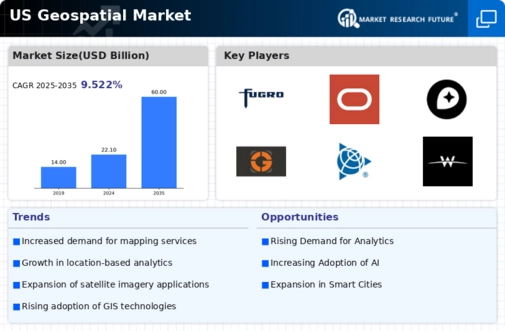Advancements in Satellite Technology
The geospatial imagery-analytics market is experiencing a surge due to advancements in satellite technology. Enhanced imaging capabilities, such as higher resolution and improved spectral analysis, allow for more detailed data collection. This is particularly relevant in sectors like agriculture, where precision farming is becoming increasingly vital. The market is projected to grow at a CAGR of approximately 15% over the next five years, driven by the demand for high-quality imagery. Furthermore, the integration of small satellites and constellations is enabling more frequent data acquisition, which is essential for timely decision-making in various industries. As satellite technology continues to evolve, it is likely to further bolster the geospatial imagery-analytics market, providing stakeholders with critical insights and fostering innovation across multiple sectors.
Emergence of Smart Agriculture Practices
The agricultural sector is undergoing a transformation, with the emergence of smart agriculture practices that leverage geospatial imagery-analytics. Farmers are increasingly adopting precision agriculture techniques to optimize crop yields and resource usage. The integration of geospatial data allows for better monitoring of soil health, crop conditions, and irrigation needs. This trend is expected to propel the geospatial imagery-analytics market, with projections indicating a growth rate of approximately 18% over the next few years. As agricultural stakeholders recognize the benefits of data-driven decision-making, investments in geospatial technologies are likely to increase. The ability to analyze spatial data effectively is becoming essential for enhancing productivity and sustainability in agriculture, thereby reinforcing the importance of the geospatial imagery-analytics market in modern farming.
Growing Demand for Urban Planning Solutions
Urbanization in the United States is accelerating, leading to a growing demand for effective urban planning solutions. The geospatial imagery-analytics market plays a crucial role in this context, offering tools that assist city planners in managing resources, infrastructure, and environmental impacts. With over 80% of the US population now living in urban areas, the need for sustainable development strategies is paramount. Geospatial analytics enables planners to visualize spatial data, assess land use, and predict future growth patterns. This trend is expected to drive significant investments in the geospatial imagery-analytics market, as municipalities seek to leverage data-driven insights for better urban management. The market's expansion is indicative of a broader shift towards smart city initiatives, which rely heavily on geospatial data to enhance urban living conditions.
Rising Importance of Environmental Monitoring
Environmental concerns are increasingly influencing the geospatial imagery-analytics market, as stakeholders seek to monitor and manage natural resources effectively. The demand for accurate environmental data is growing, particularly in the context of climate change and resource depletion. Geospatial analytics provides essential insights into land use changes, deforestation, and water resource management. The market is projected to grow significantly, with estimates suggesting an increase of over 25% in demand for environmental monitoring solutions in the coming years. This trend is driven by both governmental and non-governmental organizations that require reliable data to inform policy decisions and conservation efforts. As the focus on sustainability intensifies, the geospatial imagery-analytics market is poised to play a pivotal role in addressing environmental challenges.
Increased Adoption of Drones for Data Collection
The rise of drone technology is transforming the geospatial imagery-analytics market, particularly in data collection processes. Drones equipped with advanced imaging sensors are being utilized across various sectors, including agriculture, construction, and environmental monitoring. This shift is largely attributed to the cost-effectiveness and efficiency that drones offer compared to traditional aerial surveys. The market for drone-based geospatial analytics is expected to witness a growth rate of around 20% annually, as more organizations recognize the value of real-time data. Drones facilitate the capture of high-resolution imagery and can cover large areas in a fraction of the time, making them indispensable tools for professionals in the geospatial field. As regulations evolve to accommodate drone usage, the geospatial imagery-analytics market is likely to expand further, driven by innovation and technological advancements.























Leave a Comment